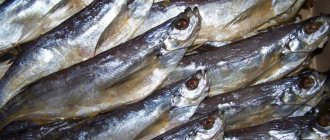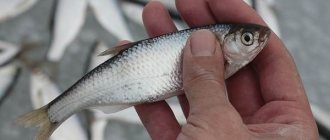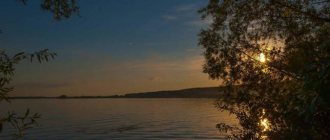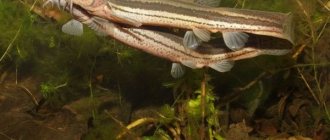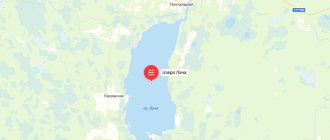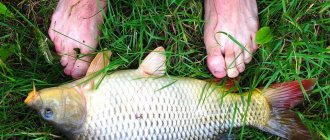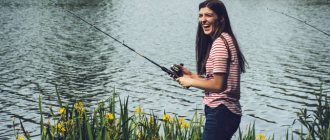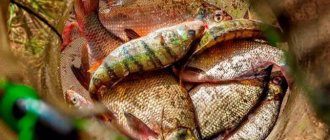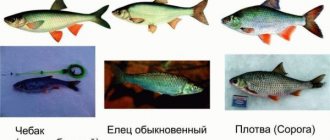The Caspian Sea is considered to be the birthplace of the carp; from there it spread to the slightly saline areas of the Black and Azov Seas. For spawning it chooses rivers - Don, Dnieper, Terek, Danube.
A fish with an unusual name, carp, belongs to the carp family. It has a number of differences and features:
- highly developed pharynx bones and teeth,
- long, thin tail with a wide, pronounced fin,
- curved head with small eyes.
The roach is considered a distant relative of the carp; they have a similar body structure, but unlike the roach, the carp has small scales and is large in size. In European countries, the carp is known as the “pearl fish”, due to the beautiful scattering of white tubercles on the scales and head of males during the breeding season.
Due to industrial fishing and water pollution in rivers, the carp population has greatly decreased. This species is listed in the International Red Book and needs protection.
Appearance, body structure
The carp's body is similar in structure to a roach, but is much larger in size and resembles an elongated block in shape. Individual representatives can reach 70 - 75 cm in length, and weight varies from 2 to 7 kg. The body is long, thickened on the sides. The head is large, wide, with a protruding forehead. The scales are mirror-silver, with a green tint. The back and head are dark gray, the sides are silvery and blend into a white belly.
There are small, black eyes on the head. The pharyngeal bones are well developed, the teeth are strong and sharp, they easily grind shells and mollusks. For this, the fish got its interesting name.
Read: Fishing for minnows: tackle, bait and fishing techniques
The fins are pointed, darker on the back, the rest lighter. The tail is pronounced, forked, dark, like the upper fin.
Kinds
In addition to the kutum carp, look at what it looks like in the photo, relatives of kutum fish include roach, roach, chub and shemae. The cutum carp is much larger. The fish has a small head with a wide forehead, a dark back, light silver sides, and a white belly. The mouth is lower, the pharyngeal teeth are in one row, but powerful enough to grind shells. Adults do not feed on their own kind, preferring barley and toothless fish, which are swallowed along with crushed shells. The dorsal and caudal fins are dark in color, the rest are grayish. The scales are much smaller and sparser than those of the kutum fish. Another difference from its relative is that during reproduction it lays eggs on a surface covered with stones. The roach looks almost identical to the kutum fish. Chub, roach and shemae do not differ in descriptions from other tribesmen. In contrast to the semi-anadromous carp, they live in one place.
Yandex pictures
Habitat, characteristic behavior
The Caspian Sea is considered the original habitat of the carp. According to research results, from here, this species spread to the basins of the Azov and Black Seas.
The habitat for semi-anadromous forms is low-salt areas of seas and tributaries of rivers - during the breeding season. Another part of the fish of this species, which belongs to the residential form, constantly lives in river tributaries and can swim quite far into the rivers.
The carp has a cautious disposition; it is bistro, timid and cautious. So frightened by movement and loud sounds, he will quickly leave the dangerous place and hide for a long time in the depths, among the stones.
The carp loves clean, cool water. Prefers the middle of the river with the fastest flow.
Lifestyle and habitat
The Caspian Sea is considered to be the original birthplace of the carp. It was from there that it spread to the Azov and Black Seas. is rare in the Volga Most often in the spring, with schools of passing fish - bream, roach, etc. But he does not rise high along the river.
It’s not found at all in the Ural River. The reason for this is most likely that these rivers are quite slow. And our swimmer chooses fast rivers with a rocky bottom and cool water. In the Dnieper and in many tributaries it is also difficult to see; it is generally not found above the rapids. Of the tributaries of the Dnieper, he chose some, like the Desna and Svisloch, where the current is faster.
But it is often found in the Dniester, Bug and Don. The carp is common in the Don River and reaches Voronezh. It can also look into the tributaries - Udu and Oskol, but is already considered a rare fish here. However, as in Kuban.
Other countries besides Russia are also familiar with it. For example, Azerbaijan, Iraq, Iran, Kazakhstan, Belarus, Moldova, Turkey, Turkmenistan. But there it is more often called “kutum”. He has not been studied enough, his way of life is little known. Largely due to the fact that he has always been a migratory fish.
And now, besides, it has become a rarity. It lives in schools on the coast, in the open sea and at river mouths. At the end of summer or beginning of autumn, it enters the rivers a little higher, spawns, spends the winter here and returns back. He is timid, cautious and quick.
Reproduction
The carp reaches sexual maturity at 4–5 years. It is characteristic that the female is larger in size than the male. During the breeding season, males grow conical, epithelial tubercles on the lateral scales and on the head; they are also called “pearl rash.” The scales become mirror silver with a red tint on the sides.
Spawning occurs in early spring and in autumn, until the first frost. Males arrive to spawn several days earlier than females. Choose a suitable place with clean water, strong currents, and a rocky bottom. For spawning, the water must warm up to 10 - 15 degrees Celsius. Males prepare selected areas, rub against stones and pebbles, and “clean up” for future offspring. The females, having arrived at the place, spawn eggs, which are carried under the stones by the current; with the help of many fibers, they stick to the stones. Males secrete milk, fertilizing the eggs. For one female, there are usually three males.
Read: Catching crayfish in winter
In another subspecies of this fish, kutum, spawning occurs with some differences. For the deposition of eggs, an area with a calmer current is selected. The soil of the reservoir does not matter. The eggs attach to algae, reed thickets and stones.
Cutters are quite prolific; during the spawning period, the female spawns more than one hundred thousand eggs.
Young individuals keep in flocks. Adult carp prefer to swim alone, scattering over considerable distances, and gather in schools only for the winter and for spawning.
Fish "Carp" photo and description
Latin name:
Rutilus frisii
Family:
Cyprinidae
Genus:
Roach
Type:
freshwater
Lifestyle:
pelagic
Diet type:
peaceful
Habitat:
Black Sea basin
Appearance:
Large fish, reaching 70 cm in length and more than 6 kg in weight. A distinctive feature of the carp is a large tail fin, smaller scales than those of roach and even ide. The back is dark, with a greenish tint, the sides are light silver, the belly is completely white, the dorsal and caudal fins are dark, the rest are grayish. The swim bladder forms a spiral at the back. The carp got its name from its strong pharyngeal bones with powerful teeth, capable of crushing fairly large mollusk shells.
Habitat and behavioral characteristics:
Distributed in the basin of the Black and Azov Seas; in the southern part of the Caspian Sea it is represented by the subspecies kutum (Rutilus frisii Kutum. The carp feeds in desalinated areas of the sea, and enters rivers for spawning. It selects rivers with fast currents and a rocky bottom, and therefore is more numerous in the Dniester and Bug than in the Dnieper or Don, where the current is slower and there is less rocky soil.In some sections of the rivers there is a residential form of carp that does not go out to the sea.
Nutrition Features:
It feeds on invertebrates and fish eggs. The basis of nutrition is shellfish.
Reproduction:
The carp begins to spawn at the age of 4-5 years, with a length of about 40 cm. To spawn, it rises into rivers. Currently, as a result of the construction of dams in a number of rivers (Northern Donets, Oskol, Uda, Ros and some others), the carp has turned from a semi-anadromous form into a residential one. The number of residential forms is small. In the Southern Bug, two runs of carp are observed: the spring run, which begins with the first ice movements and ends in April, and the autumn run, from July until freeze-up. Carp that enter the river in winter and spring spawn in the same year; those that enter the river in summer and autumn spawn the following year. Males going into the river differ from females in their unusually beautiful nuptial plumage: the head, back and sides, mainly above the lateral line, are covered with conical hard tubercles of a milky pearl color, the fins acquire a pinkish-blue color with a pearlescent tint. It is interesting to note that the nuptial plumage is present in both spring and autumn males, although the latter will spawn only after 8-10 months. At the end of spawning, the tubercles disappear. Spawning begins in early May and lasts about three weeks, with spawning occurring both during the day and at night. The female, accompanied by three or even four males, rubs her belly against the stones so hard that abrasions and wounds appear on it. In turn, the males rub their heads and sides, strewn with hard tubercles, against the female. Fertilized eggs stick to stones, hatched larvae are photophobic and hide under stones. Kutum is a commercial fish of the Middle and Southern Caspian Sea. It spawns in slowly flowing water near river mouths on a variety of substrates: on freshly flooded vegetation, in thickets of reeds, on washed-out rhizomes of coastal vegetation, as well as on rocky ground. The nature of egg development and behavior of kutum larvae differ from those of carp. Kutum larvae are suspended with the help of special organs from plants in quiet, overgrown areas of the river, where the current carries them.
FISH CATALOG


